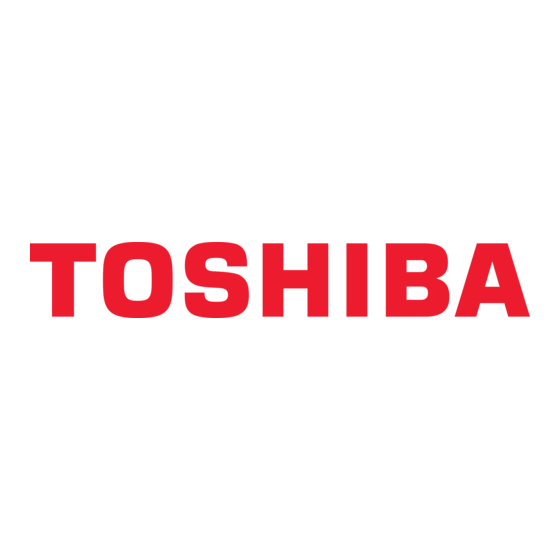
Table of Contents
Advertisement
Quick Links
Advertisement
Table of Contents

Summarization of Contents
TOSHIBA Legal, Regulatory and Safety
Copyright, Disclaimer, and Trademarks
Details copyright, disclaimer, and trademark information for the manual and product.
Regulatory Information
Outlines legal, regulatory, and safety compliance information for the computer.
EU Declaration of Conformity
Covers EU conformity notices, declarations, and CE compliance.
Regional Regulatory Information
Specifies regulatory compliance for Japan (VCCI) and Canada.
Product Disposal and Compliance
Provides information on product disposal and REACH compliance statements.
Product Notices and Licenses
Includes video standards, OpenSSL licenses, and ENERGY STAR program details.
ENERGY STAR® Program
Details the ENERGY STAR program and its benefits for energy efficiency.
General Precautions
Offers essential safety guidelines for computer operation, environment, and user well-being.
Physical Safety and Maintenance
Covers prevention of stress, heat injuries, and cleaning procedures.
Operational Safety Guidelines
Provides advice on moving, using mobile phones, and safety icons.
Getting Started
Equipment Checklist and First Use
Lists included hardware, guides initial computer setup, and first-time usage.
Connecting the Keyboard Dock
Explains how to connect the TOSHIBA Keyboard Dock to the computer.
Connecting the AC Adaptor
Details how to connect the AC adaptor for power and battery charging.
Powering On and Initial Setup
Guides on turning on the computer and performing initial operating system setup.
Understanding Windows Basics
Introduces Windows 8 features like Start screen, Charms, and Tiles.
Managing Power States
Covers turning off, shutting down, restarting, Sleep, and Hibernation modes.
The Grand Tour
Computer Exterior Views
Describes the physical layout and components of the computer from various angles.
Internal Hardware Components
Details the computer's internal parts like CPU, hard drive, and battery.
Power Condition Descriptions
Explains the status indicators for AC power and battery charge.
Operating Basics
Tablet Mode Operation
Guides on using the computer in tablet mode and changing screen orientation.
Touch Interface Usage
Explains how to use the touch screen and touch pad gestures.
Keyboard Features
Covers keyboard layout, function keys, special keys, and touch keyboard.
Battery Usage and Management
Details battery types, charging, monitoring, and extending battery life.
Memory Media Operations
Instructions for using memory media slots, including insertion and removal.
External Display Connectivity
Guides on connecting external displays via HDMI and selecting display settings.
Audio and Video Settings
Covers volume control, microphone settings, and video mode configurations.
Utilities and Advanced Usage
System Utilities Overview
Introduces pre-installed utilities and how to access them via Desktop Assist.
System Configuration Tools
Details utilities for display, password, system settings, HDD acceleration, and BIOS setup.
Special Software Features
Explains utilities like eco mode, media player, function keys, and service station.
System Monitoring and Enhancements
Describes PC Health Monitor, Resolution+, and Audio Enhancement utilities.
Advanced Power Management
Covers features like automatic power off, sleep/hibernation modes, and battery saving.
Security and System Settings
Details password utilities, system settings, and their configurations.
Media Player and System Health
Guides on using TOSHIBA Media Player and PC Health Monitor.
System Setup and Recovery
Instructions for using TOSHIBA Setup Utility and system recovery options.
USB Charging Features
Explains USB charging capabilities like Sleep and Charge and System ON CDP Charge.
Troubleshooting
Problem Solving Approach
Outlines systematic steps for identifying and resolving computer problems.
Hardware Troubleshooting
Addresses common hardware issues related to power, input, display, storage, and connectivity.
Power and Battery Issues
Diagnoses problems with AC power, battery charging, and computer power down.
Input and Display Issues
Solves problems with keyboard, display panel, pointing devices, and USB mice.
Storage and Media Issues
Addresses performance issues with Solid State Drives and memory media cards.
Connectivity Issues
Troubleshoots sound systems, external monitors, wireless LAN, and Bluetooth.
Appendix
Technical Specifications
Summarizes physical dimensions, environmental requirements, and power specifications.
Power Cord and Certification
Details AC power cord compatibility and certification agency information.
Wireless Device Information and Regulations
Covers wireless technology interoperability, health, regulations, and regional use.
Legal Footnotes and Definitions
Provides explanations for CPU, memory, battery life, storage, and technical terms.












Need help?
Do you have a question about the Satellite W30Dt-A Series and is the answer not in the manual?
Questions and answers